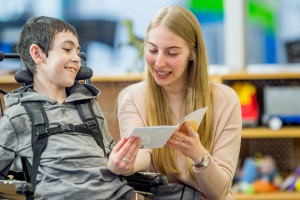Red Rocks Community College’s Childhood Education Program is in line with B.O.L.D. 2026 goals, which include increasing the number of childcare specialists in Jefferson County to help caregivers enter the workforce and provide high-quality early learning experiences for children. The program’s worth has increased dramatically in recent years due to the fact that 80% of daycare facilities are facing a staffing shortage, an issue that became worse during the epidemic.
According to Janiece Kneppe, Ed.D., faculty lead of the RRCC program, requiring candidates to the profession to experience a variety of training and career options, such as home-based child care programs versus center-based childcare and preschool teaching, will help increase the number of local childcare specialists.
The Early Childhood Education (ECE) Associate’s degree program provides two degrees: an AA-Early Childhood Teacher Education degree that transfers to 4-year programs leading to a Bachelor’s degree, and an Associate of Applied Science in ECE. Enrolled in 15 ECE classes are 159 college students and 23 concurrent high school students from the ECE program. In a semester, most students enroll in two courses. An associate’s degree program can take five years to complete.
Most students are seeking the AAS degree, which provides a range of early childhood job opportunities, such as working as a home childcare provider, owning or running a community-based childcare facility, or pursuing other related careers. Approximately 5% of students pursuing an AA degree will become licensed teachers, enabling them to instruct kids in kindergarten through third grade in public schools. Kneppe claims, “My students are nontraditional.” “They are mostly women between the ages of 27 and 45 who have their own families.”

Combinations of real-time experience and flexible, integrated learning are crucial. Thus, RRCC provides:
RRCC’s on-site practicums The Children’s Center typically enrolls 45–55 children between the ages of 18 months and 5 who are taught by 8 teachers. The Children’s Center integrates learning across all subject areas while using an emergent curriculum that is centered on the interests of the kids. At least one practicum course will be completed by each ECE student. The RRCC Children’s Center is a place where students can finish their practicum hours if they are not currently employed by an early childhood program. Students in the ECE program are usually placed in the Children’s Center or other early childhood programs in the community with which they have developed partnerships.
Fast-track licensure: According to Kneppe, students can stack certifications that lead to recognized qualifications with childcare license in instead of earning an Associate’s degree. The EC Assistant Teacher certificate (6 credits), ECE certificate (12 credits), and Early Childhood Teacher certificate (18 credits) can be obtained by enrolling in two courses at a time. This is the most efficient way to obtain these qualifications. Any early childhood professional working in a center or at home can utilize these certifications to advance their EC credentials in the Professional Development Information System (PDIS).
External apprenticeships: Early childhood apprenticeships that are federally registered are accessible through the Child Care Innovations Center at RRCC. These apprentices have the option to enroll in RRCC’s ECE program in order to use the work-based learning experiences they acquire from the apprenticeship to obtain the certifications and AAS-ECE degree. Child Care Innovations offers an apprenticeship program that serves apprentices throughout Colorado. It’s gaining popularity as a means of gaining experience and training to become a great early childhood educator while earning a wage.









Comments on " B.O.L.D. Bites: Three Essential Details Regarding RRCC’s Early Childhood Education InitiativeWritten by Senior Vice President of Strategic Impact Marsha Barancik" :